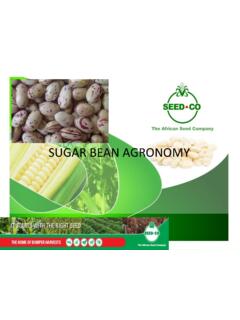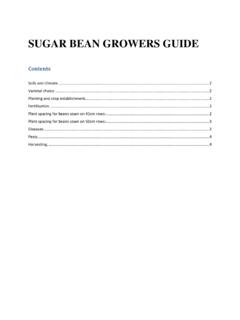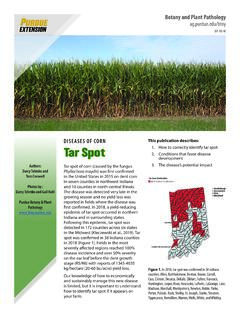Transcription of MAIZE GROWERS GUIDE - Seed Co Limited
1 MAIZE GROWERS GUIDE Table of Contents Soils and climate .. 2 Fertilisation .. 2 Plant spacing .. 6 New trends in population density management-commercial .. 12 Planting date .. 12 Varietal choice .. 13 Planting .. 15 Mid-season management .. 17 Hard facts about weeds in MAIZE .. 18 Yield forecasting in MAIZE .. 18 2 Soils and climate MAIZE grows best on deep, well-drained, fertile soils, and where total seasonal rainfall exceeds 500 mm. MAIZE is reasonably tolerant to soil acidity, but if the soil is very acid, liming will improve the soil and enhance MAIZE yields. MAIZE is susceptible to both drought and water-logging. Thus, poorly drained soils should be avoided, unless practices like ridge tillage, drainage and early planting are employed.
2 Drought during the four week period spanning flowering (silking and tasseling) can cause serious yield losses, and therefore some form of water conservation is important ( , pot-holing, mulching, tied-ridges), especially in the drier areas. Temperatures above 38 degrees celcius affect yield by affaceting pollen viability while temperatures below 10 retards MAIZE growth. Fertilisation The fertiliser requirements of MAIZE depends on the soil fertility and yield target. Infertile soils require more fertiliser, as does a higher yield target. The two most important nutrients for MAIZE are nitrogen and phosphorous, but MAIZE also requires potassium and, on some soils, Zinc in small quantities.
3 The first consideration for fertilising MAIZE is manure, for it is an excellent source of nutrients and has many other benefits for soils. Bought inorganic fertilisers should be considered as a supplement to manure. The following table gives a general recommendation for fertilising MAIZE with inorganic fertilisers: 3 Yield potential of MAIZE Fertiliser Less than 3 to 5 t/ha 5 to 8 t/ha 8 to > 12 t/ha Type 3 t/ha Number of 50kg bags of fertiliser per ha Basal fertilizer 0 to 3 bags/ha 2 to 5 bags/ha 5 to 7 bags/ha 6 to 12 bags/ha ( 7:14:7) (0 to 150kg/ha) (100 to 250kg/ha) (250 to 350kg/ha) (300 to 600kg/ha) Top dressing fertilizer 1 to 3 bags/ha 2 to 5 bags/ha 5 to 7 bags/ha 6 to 10 bags/ha (high N) (50 to 150kg/ha) (100 to 250kg/ha) (250 to 350kg/ha) (250 to 500kg/ha) ammonium nitrate ( N) Facts.
4 The yield potential largely depends on the variety, expected rainfall and on the management applied to the crop. The addition of manure and ash will greatly improve the response of MAIZE to the applied fertiliser. Under commercial set ups addition of lime to acidic soils improve response to fertilisers Fertiliser rates may be reduced after a drought, where manure and ash is applied or when the MAIZE is following a legume or well-fertilised crop, like potatoes. 4 The basal fertiliser must be applied before or at the time of planting, preferably cupped into the planting hole, or applied in a band below and to the side of the seed with the mechanical planter. The top dressing should be applied when the MAIZE at to 6 Weeks After crop Emergence-WACE.
5 Top dressing splits may be recommended in sandy to sandy loam soils. A maximum of 3 usually is ideal Basal fertilisers which contains zinc are recommended for application every two to three years on sandy soils. If boronated fertilisers are not normally applied as part of the rotation, then a boronated fertiliser should be applied every three years. The approximate application rates (to the nearest half-bag) of inorganic fertilisers to crops can be determined from the following tables: Basal fertilizers 7,14,7 Plant Spacing Cup size Between Between 5 8 12 16 22 Rows Plants Fertilizer rate (kg/ha) (Cm) (Cm) 5 100 50 125 200 275 375 525 90 60 100 175 250 350 475 90 50 125 250 300 425 575 90 30 200 350 525 700 950 75 60 125 200 300 425 575 50 50 250 375 550 750 1050 Top Dressing Fertilizers (TOP) N Plant Spacing Cup size Between Between 5 8 12 16 22 Rows Plants Fertilizer rate (kg/ha) (Cm) (Cm)
6 100 50 100 150 250 325 450 90 60 100 150 225 300 400 6 90 50 100 175 250 350 500 90 30 200 300 450 600 800 75 60 100 175 250 350 500 50 50 200 325 500 650 875 NOTE: 1 ha = acres 1 bag of fertiliser = 50kg To convert kg/ha to bags per hectare, divide by 100 and multiply by 2. To convert kg/ha to kg per acre, divide by (or multiply by ). Specific amounts of fertilizer will vary according to the specific density of the fertilizer used. Plant spacing The width of rows and the spacing of plants in the row determines the plant population. The closer the spacing, the more plants there will be per unit area. The recommended number of MAIZE plants per hectare varies from 36,000 to 60,000, depending on the environmental yield potential and hybrid .
7 High plant populations are appropriate for early-planted crops under high rainfall or irrigated conditions where management is of a good standard. Lower plant populations 7 should be used under dryland conditions, especially in drought prone areas, where a population of about 37,000 to 40, 000 plants per hectare is recommended. Some varieties may be susceptible to lodging under high plant populations. Generally, the taller the variety, the lower should be the plant population. Short MAIZE varieties may be grown at higher plant populations. Whatever the case, the minimum plant population for MAIZE is 36,000 plants per ha. 8 The plant populations for the various seed Co hybrids related to the expected yield is presented in the Table below.
8 HYBRIDS ULTRA & VERY EARLY EARLY MEDIUM LATE SC719 SC727 Expected SC403 SC513 SC533 SC608(Y) Yield SC417 SC529 SC533 SC537 SC637 SC633 T/ha SC419 SC627 SC402 SC649 SC 643 1 36000 32000 2 36000 36000 32000 3 40000 36000 36000 32000 36000 4 40000 40000 36000 32000 36000 5 44000 40000 40000 36000 40000 6 44000 44000 40000 36000 40000 7 48000 44000 40000 40000 44000 37000 8 52000 48000 44000 44000 47000 40000 9 56000 55000 48000 48000 48000 48000 10 60000 52000 49000 48000 49000 11 56000 50000 50000 50000 12 SC419@60k 60000 55000 60000 52000 13 55000 60000 52000 14 55000 60000 55000 >15 55000 9 A seed rate of about 25 kg/ha is required, but this depends on the seed size.
9 10 kg is enough to plant 1 acre and 5 kg for half an acre. Small seed will go further, and give equal germination and yield performance as large seed . However, small seed should not be planted too deep ( , not deeper than 5 cm). For SC 727, a 50, 000 kernel (1 hectare pack) is enough to plant 1 Ha, 20, 000 kernel for 1 Acre. The following table gives the number of plants per hectare at various spacings for hand planting: Spacing Spacing between plant Number of Plant population between rows station plants per (plants per ha) (cm) (cm) station 100 60 2 33 300 100 50 2 40 000 90 60 2 37 000 90 30 1 37 000 90 50 2 44 400 90 40 2 55 500 75 60 2 44 400 90 22 1 50 500 75 24 1 55 555 75 25 1 53 333 10 Key: Recommended in low rainfall areas regions 4 &5 Recommended in high rainfall areas region 1 to 3 or irrigated areas NB: To derive your population per hectare divide 10,000 by your row spacing (m) and then divide the answer by the spacing between the plant stations in metres.
10 Multiply the answer by the number of plants per station. The following table gives the plant spacing and seed rate requirements when machine planting: Target Required Average kernel Average number of Hectares planted per 25kg bag Spacing in-row (cm) kernels per row Harvest Planting Population Population Row width (m) Row width (m) Large seed size Small Per ha Per ha Medium 1600 seeds/kg 2100 seeds/kg 2400 seeds/kg 25 000 28 070 48 40 32 000 35 100 38 32 11 38 000 42 100 32 26 44 000 49 100 27 23 51 000 56 100 24 20 57 000 63 200 21 18 63 000 70 200 19 16 69 000 77 200 17 14 Note.







